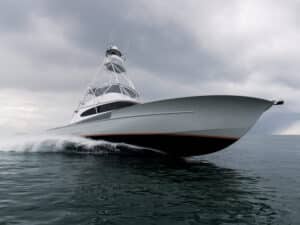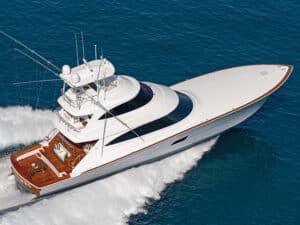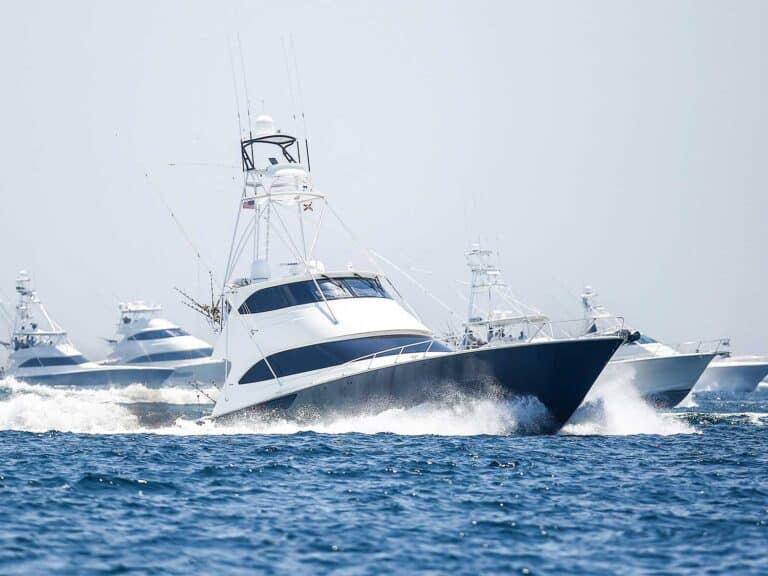The azaleas added splashes of color to virtually every yard, while wild dogwoods and wisteria lined the roadsides at the height of spring in the lovely town of Edenton, in eastern North Carolina. Our test day proved to be glassy calm, not exactly an Albemarle’s ‘ost challenging milieu.
Having run every model of Albemarle ever built, I can vouch for their sea-keeping ability, despite how tough testing that ability might have been this time. Nonetheless, I was able to set up some 4-foot wakes to run through and drift beam-to in to assess the 410’s ‘bilities.
Over the years, I’ve’come to expect certain performance characteristics from every Albemarle. The sharp entry cuts into head seas, the deep V lands softly and the heavy construction makes for a gentle ride. The 410 exhibited all these traits. Though it scribes a fairly substantial arc when rolling in a beam-to drift, the 410 generates gentle and predictable transitions, keeping passengers comfortable.
Twin Cat 3196 turbo diesels putting out 660 hp each provide more than enough giddyap, pushing this heavier-than-average 41-footer to a top speed of almost 39 mph with no tabs. I found that she runs faster with just a touch of tab, 40.2 mph at 2,400 rpm. With its Don Blount-designed bottom, the 410 jumps onto plane in a mere 10 seconds — q-icker than most diesel-powered sport-fishermen. Cruising at 34.5 mph, a 180-degree turn took about 10 boat lengths (an unusually large arc for an Albemarle) and surprisingly without the normally dramatic Albemarle lean into the turn. And the 410 answers one of the major complaints about express boats by providing better-than-average visibility.
The 410’s cockpit provides more than enough room for a fighting chair to swivel even with the transom-mounted kill box. Modules with storage beneath located on the leading edge of the cockpit contain an insulated baitwell to port and stainless sink and rigging station to starboard. Indentations on Albemarle’s modules allow you to close the tops without smashing your fingers — u-like on many comparable boats. I appreciate the accommodation, but would prefer to see the indents run all the way across the front rather than occupy just a narrow space at the center of the facing.
The bridge deck lifts on electric rams to reveal a compact engine room with wiring and plumbing carefully run and easily traced. Atop the bridge deck, seating for at least eight people can be enjoyed on two J-shaped settees. Of course you’ll’find the obligatory tackle storage beneath both and tackle drawers in the starboard settee.
Five steps into the portside access lead to the galley with its Corian counters, convection oven, cooktop, ice maker and copious cabinetry. A salon/dinette to starboard faces what you might expect to be a pullman berth to port, which when opened actually reveals excellent rod storage for big tackle. The salon could comfortably seat four to five, though not facing each other as at a normal table. Its crescent shape reminds me of a cabaret. The accommodations round out with an exceptionally handsome stand-up head with shower and a private forward stateroom with a large island berth.
Throughout the Albemarle, the word that comes to mind is solid – solid fiberglass, solid stringers, solid teak cabinetry. Even the hull consists of 24-ounce woven fiberglass combined with chopped glass as a print-through barrier. Albemarle uses no composite anywhere in the boat, just solid fiberglass.
Albemarle builds boats that you can pass on to your children. They’ll’take great care of you offshore for as many years as you care to go there.







